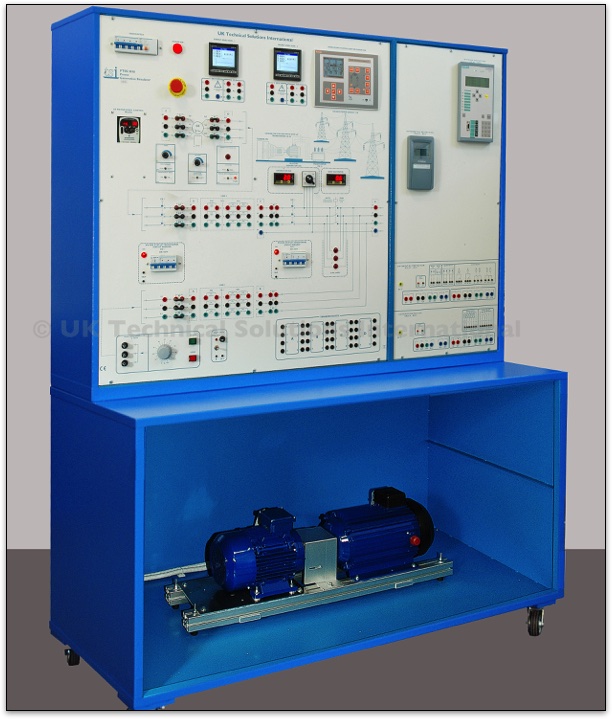
TSI-PTSS 5010 Power Generation Module
This unit simulates a power plant with a substation and high-voltage line output. It includes different resistors/reactors that can be used to simulate synchronous machines with different power outputs.
It also includes a programmable multifunction differential relay that can be used to protect both the generator and the transformer.
A distance protection relay is also included to protect the HV output line.
The module is equipped with two digital multifunction 3-phase instruments for measuring voltage, current, active power, reactive power and harmonics.
The unit has four sections:
Section 1 - Static 50/60 Hz generator (this simulates an infinite power grid).
Section 2 - Rotating generator group
Section 3 - Generator control panel
Section 4 - Protection Relays
Section 1 - Static 50Hz or 60Hz generator
This simulates an infinite power grid where power generation is represented by a 3-phase variable autotransformer and a fixed 3-phase transformer. The transformer can be connected in delta/star and vice versa. A number of different taps are available to simulate different HV voltages. It has a rated power of 2kVA and an output voltage range of 0-230V/0-400V
Section 2 - Rotating generator group
This incorporates a synchronous machine that is mechanically coupled to an AC 3-phase motor. An electronic variable motor drive connected to the AC motor allows for changes in the speed and torque of the synchronous machine.
A DC excitation control allows for changes in the voltage and reactive power of the synchronous machine.
It has the following characteristics:
Rated power: 1kVA, Output voltage: 0-240V/0-420V, Field voltage: 200V, Nominal speed: 3600 RPM
Section 3 – Generator control panel
This provides two selectable modes of synchronisation operation:
Manual
This allows the manual selection of parallel synchronisation between the output of the rotating synchronous machine and the infinite power grid using voltmeters, zero-voltmeter and a synchroscope.
Automatic
This mode is designed to automatically adjust the speed, voltage and phase shifting of the rotating generator in order to automatically manage the synchronisation and paralleling between the generator and the mains supply.
The adjustment of the parameters of the PID control loops can be done experimentally by the trainee. After successful parallel synchronisation it is possible to share the load between the mains and the synchronous generator.
An outgoing bus system is used to connect the power generation module to the HV and or MV transmission line modules.
Section 4 – Protection Relays
A series of different protection relays are installed on the power generation module. These include:
1 x Multifunction differential relay (87).
This protection relay provides the differential protection for the electrical machines (generators, motors and transformers) against internal faults.
It also provides the following additional protections:
- Undercurrent (37)
- Reverse-phase or phase-balance 46)
- Machine or transformer thermal relay (49)
- Instantaneous over-current relay (50)
- AC time over-current relay (51).
- Trip circuit supervision (74CT).
1 x Non-switched distance protection relay with 6 measuring systems (21/21N).
This provides:
- High resistance ground-fault protection for single and three-pole tripping (50N, 51N, 67N)
- Ground-fault detection in isolated and resonant-grounded networks
- Tele (pilot) protection (85)
- Fault locator (FL)
- Power-swing detection/tripping (68/68T)
- Phase over-current protection (50/51/67)
- Switch-onto-fault protection (50HS)
- STUB bus over-current protection (50STUB)
- Over-voltage/under-voltage protection (59/27)
- Over/under-frequency protection (81O/U)
- Auto-reclosure (79)
- Synchro-check (25)
- Breaker failure protection (50BF)
- Thermal overload protection (49)
This relay is suitable for selective protection of the outgoing HV lines.
A unique system of Transfer Blocks is also included on the unit to allow simple electrical connections with equipment located on the other modules.
